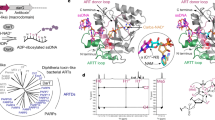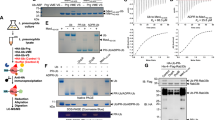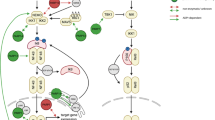Abstract
ADP-ribosylation—the transfer of ADP-ribose (ADPr) from NAD+ onto target molecules—is catalyzed by members of the ADP-ribosyltransferase (ART) superfamily of proteins, found in all kingdoms of life. Modification of amino acids in protein targets by ADPr regulates critical cellular pathways in eukaryotes and underlies the pathogenicity of certain bacteria. Several members of the ART superfamily are highly relevant for disease; these include the poly(ADP-ribose) polymerases (PARPs), recently shown to be important cancer targets, and the bacterial toxins diphtheria toxin and cholera toxin, long known to be responsible for the symptoms of diphtheria and cholera that result in morbidity. In this Review, we discuss the functions of amino acid ADPr modifications and the ART proteins that make them, the nature of the chemical linkage between ADPr and its targets and how this impacts function and stability, and the way that ARTs select specific amino acids in targets to modify.
This is a preview of subscription content, access via your institution
Access options
Access Nature and 54 other Nature Portfolio journals
Get Nature+, our best-value online-access subscription
$29.99 / 30 days
cancel any time
Subscribe to this journal
Receive 12 print issues and online access
$259.00 per year
only $21.58 per issue
Buy this article
- Purchase on Springer Link
- Instant access to full article PDF
Prices may be subject to local taxes which are calculated during checkout




Similar content being viewed by others
References
Aravind, L., Zhang, D., de Souza, R.F., Anand, S. & Iyer, L.M. in Endogenous ADP-Ribosylation (ed. Koch-Nolte, F.) 3–32 (Springer International Publishing, 2015).
Bazan, J.F. & Koch-Nolte, F. Sequence and structural links between distant ADP-ribosyltransferase families. Adv. Exp. Med. Biol. 419, 99–107 (1997).
Culver, G.M. et al. An NAD derivative produced during transfer RNA splicing: ADP-ribose 1″-2″ cyclic phosphate. Science 261, 206–208 (1993).
Spinelli, S.L., Kierzek, R., Turner, D.H. & Phizicky, E.M. Transient ADP-ribosylation of a 2′-phosphate implicated in its removal from ligated tRNA during splicing in yeast. J. Biol. Chem. 274, 2637–2644 (1999).
Lyons, B. et al. Scabin, a novel DNA-acting ADP-ribosyltransferase from Streptomyces scabies. J. Biol. Chem. 291, 11198–11215 (2016).
Takamura-Enya, T. et al. Mono(ADP-ribosyl)ation of 2′-deoxyguanosine residue in DNA by an apoptosis-inducing protein, pierisin-1, from cabbage butterfly. Proc. Natl. Acad. Sci. USA 98, 12414–12419 (2001).
Nakano, T. et al. Purification and molecular cloning of a DNA ADP-ribosylating protein, CARP-1, from the edible clam Meretrix lamarckii. Proc. Natl. Acad. Sci. USA 103, 13652–13657 (2006).
Jankevicius, G., Ariza, A., Ahel, M. & Ahel, I. The toxin-antitoxin system DarTG catalyzes reversible ADP-ribosylation of DNA. Mol. Cell 64, 1109–1116 (2016).
Munnur, D. & Ahel, I. Reversible mono-ADP-ribosylation of DNA breaks. FEBS J. 284, 4002–4016 (2017).
Dabbs, E.R. et al. Ribosylation by mycobacterial strains as a new mechanism of rifampin inactivation. Antimicrob. Agents Chemother. 39, 1007–1009 (1995).
Baysarowich, J. et al. Rifamycin antibiotic resistance by ADP-ribosylation: Structure and diversity of Arr. Proc. Natl. Acad. Sci. USA 105, 4886–4891 (2008).
Jwa, M. & Chang, P. PARP16 is a tail-anchored endoplasmic reticulum protein required for the PERK- and IRE1α-mediated unfolded protein response. Nat. Cell Biol. 14, 1223–1230 (2012).
Zhang, Y. et al. RNF146 is a poly(ADP-ribose)-directed E3 ligase that regulates axin degradation and Wnt signalling. Nat. Cell Biol. 13, 623–629 (2011).
DaRosa, P.A. et al. Allosteric activation of the RNF146 ubiquitin ligase by a poly(ADP-ribosyl)ation signal. Nature 517, 223–226 (2015).
Wang, Z. et al. Recognition of the iso-ADP-ribose moiety in poly(ADP-ribose) by WWE domains suggests a general mechanism for poly(ADP-ribosyl)ation-dependent ubiquitination. Genes Dev. 26, 235–240 (2012).
Zhou, Z.-D., Chan, C.H.-S., Xiao, Z.-C. & Tan, E.-K. Ringfinger protein 146/Iduna is a poly(ADP-ribose) polymer binding and PARsylation dependent E3 ubiquitin ligase. Cell Adh. Migr. 5, 463–471 (2011).
Chang, P., Jacobson, M.K. & Mitchison, T.J. Poly(ADP-ribose) is required for spindle assembly and structure. Nature 432, 645–649 (2004).
Chang, P., Coughlin, M. & Mitchison, T.J. Interaction between Poly(ADP-ribose) and NuMA contributes to mitotic spindle pole assembly. Mol. Biol. Cell 20, 4575–4585 (2009).
Vyas, S. & Chang, P. New PARP targets for cancer therapy. Nat. Rev. Cancer 14, 502–509 (2014).
Chang, P., Coughlin, M. & Mitchison, T.J. Tankyrase-1 polymerization of poly(ADP-ribose) is required for spindle structure and function. Nat. Cell Biol. 7, 1133–1139 (2005).
Gibson, B.A. & Kraus, W.L. New insights into the molecular and cellular functions of poly(ADP-ribose) and PARPs. Nat. Rev. Mol. Cell Biol. 13, 411–424 (2012).
Ahel, I. et al. Poly(ADP-ribose)-binding zinc finger motifs in DNA repair/checkpoint proteins. Nature 451, 81–85 (2008).
Barkauskaite, E., Jankevicius, G. & Ahel, I. Structures and mechanisms of enzymes employed in the synthesis and degradation of PARP-dependent protein ADP-ribosylation. Mol. Cell 58, 935–946 (2015).
Jankevicius, G. et al. A family of macrodomain proteins reverses cellular mono-ADP-ribosylation. Nat. Struct. Mol. Biol. 20, 508–514 (2013).
Rosenthal, F. et al. Macrodomain-containing proteins are new mono-ADP-ribosylhydrolases. Nat. Struct. Mol. Biol. 20, 502–507 (2013).
Sharifi, R. et al. Deficiency of terminal ADP-ribose protein glycohydrolase TARG1/C6orf130 in neurodegenerative disease. EMBO J. 32, 1225–1237 (2013).
De Haan, L. & Hirst, T.R. Cholera toxin: a paradigm for multi-functional engagement of cellular mechanisms (Review). Mol. Membr. Biol. 21, 77–92 (2004).
Ueda, K. & Hayaishi, O. ADP-ribosylation. Annu. Rev. Biochem. 54, 73–100 (1985).
Corda, D. & Di Girolamo, M. Functional aspects of protein mono-ADP-ribosylation. EMBO J. 22, 1953–1958 (2003).
Koch-Nolte, F. ed. Endogenous ADP-Ribosylation 1st edn, Vol. 384 (Springer International Publishing, 2015).
de Souza, R.F. & Aravind, L. Identification of novel components of NAD-utilizing metabolic pathways and prediction of their biochemical functions. Mol. Biosyst. 8, 1661–1677 (2012).
Rao, S.T. & Rossmann, M.G. Comparison of super-secondary structures in proteins. J. Mol. Biol. 76, 241–256 (1973).
Vyas, S., Chesarone-Cataldo, M., Todorova, T., Huang, Y.-H. & Chang, P. A systematic analysis of the PARP protein family identifies new functions critical for cell physiology. Nat. Commun. 4, 2240 (2013).
Bock, F.J. & Chang, P. New directions in poly(ADP-ribose) polymerase biology. FEBS J. 283, 4017–4031 (2016).
Hottiger, M.O., Hassa, P.O., Lüscher, B., Schüler, H. & Koch-Nolte, F. Toward a unified nomenclature for mammalian ADP-ribosyltransferases. Trends Biochem. Sci. 35, 208–219 (2010).
Pinto, A.F. & Schüler, H. Comparative structural analysis of the putative mono-ADP-ribosyltransferases of the ARTD/PARP family. Curr. Top. Microbiol. Immunol. 384, 153–166 (2015).
Sun, J., Maresso, A.W., Kim, J.-J.P. & Barbieri, J.T. How bacterial ADP-ribosylating toxins recognize substrates. Nat. Struct. Mol. Biol. 11, 868–876 (2004).
Jørgensen, R., Wang, Y., Visschedyk, D. & Merrill, A.R. The nature and character of the transition state for the ADP-ribosyltransferase reaction. EMBO Rep. 9, 802–809 (2008).
Laing, S., Unger, M., Koch-Nolte, F. & Haag, F. ADP-ribosylation of arginine. Amino Acids 41, 257–269 (2011).
Chung, D.W. & Collier, R.J. Enzymatically active peptide from the adenosine diphosphate-ribosylating toxin of Pseudomonas aeruginosa. Infect. Immun. 16, 832–841 (1977).
Seman, M., Adriouch, S., Haag, F. & Koch-Nolte, F. Ecto-ADP-ribosyltransferases (ARTs): emerging actors in cell communication and signaling. Curr. Med. Chem. 11, 857–872 (2004).
Todorova, T., Bock, F.J. & Chang, P. Poly(ADP-ribose) polymerase-13 and RNA regulation in immunity and cancer. Trends Mol. Med. 21, 373–384 (2015).
Iwata, H. et al. PARP9 and PARP14 cross-regulate macrophage activation via STAT1 ADP-ribosylation. Nat. Commun. 7, 12849 (2016).
Kozaki, T. et al. Mitochondrial damage elicits a TCDD-inducible poly(ADP-ribose) polymerase-mediated antiviral response. Proc. Natl. Acad. Sci. USA 114, 2681–2686 (2017).
Atasheva, S., Frolova, E.I. & Frolov, I. Interferon-stimulated poly(ADP-ribose) polymerases are potent inhibitors of cellular translation and virus replication. J. Virol. 88, 2116–2130 (2014).
Leung, A.K.L. et al. Poly(ADP-ribose) regulates stress responses and microRNA activity in the cytoplasm. Mol. Cell 42, 489–499 (2011).
Bock, F.J., Todorova, T.T. & Chang, P. RNA regulation by poly(ADP-ribose) polymerases. Mol. Cell 58, 959–969 (2015).
Todorova, T., Bock, F.J. & Chang, P. PARP13 regulates cellular mRNA post-transcriptionally and functions as a pro-apoptotic factor by destabilizing TRAILR4 transcript. Nat. Commun. 5, 5362 (2014).
Gupte, R., Liu, Z. & Kraus, W.L. PARPs and ADP-ribosylation: recent advances linking molecular functions to biological outcomes. Genes Dev. 31, 101–126 (2017).
Gibson, B.A. et al. Chemical genetic discovery of PARP targets reveals a role for PARP-1 in transcription elongation. Science 353, 45–50 (2016).
Kleine, H. et al. Substrate-assisted catalysis by PARP10 limits its activity to mono-ADP-ribosylation. Mol. Cell 32, 57–69 (2008).
Vyas, S. et al. Family-wide analysis of poly(ADP-ribose) polymerase activity. Nat. Commun. 5, 4426 (2014).
Daniels, C.M., Ong, S.E. & Leung, A.K.L. The promise of proteomics for the study of ADP-ribosylation. Mol. Cell 58, 911–924 (2015).
Gibbs-Seymour, I., Fontana, P., Rack, J.G.M. & Ahel, I. HPF1/C4orf27 is a PARP-1-interacting protein that regulates PARP-1 ADP-ribosylation activity. Mol. Cell 62, 432–442 (2016).
Altmeyer, M., Messner, S., Hassa, P.O., Fey, M. & Hottiger, M.O. Molecular mechanism of poly(ADP-ribosyl)ation by PARP1 and identification of lysine residues as ADP-ribose acceptor sites. Nucleic Acids Res. 37, 3723–3738 (2009).
Bilan, V., Leutert, M., Nanni, P., Panse, C. & Hottiger, M.O. Combining higher-energy collision dissociation and electron-transfer/higher-energy collision dissociation fragmentation in a product-dependent manner confidently assigns proteomewide ADP-ribose acceptor sites. Anal. Chem. 89, 1523–1530 (2017).
Bonfiglio, J.J. et al. Serine ADP-ribosylation depends on HPF1. Mol. Cell 65, 932–940.e6 (2017).
Leidecker, O. et al. Serine is a new target residue for endogenous ADP-ribosylation on histones. Nat. Chem. Biol. 12, 998–1000 (2016).
Morgan, R.K. & Cohen, M.S. A clickable aminooxy probe for monitoring cellular ADP-ribosylation. ACS Chem. Biol. 10, 1778–1784 (2015).
Cervantes-Laurean, D., Jacobson, E.L. & Jacobson, M.K. Glycation and glycoxidation of histones by ADP-ribose. J. Biol. Chem. 271, 10461–10469 (1996).
Oka, S., Kato, J. & Moss, J. Identification and characterization of a mammalian 39-kDa poly(ADP-ribose) glycohydrolase. J. Biol. Chem. 281, 705–713 (2006).
Fontana, P. et al. Serine ADP-ribosylation reversal by the hydrolase ARH3. eLife 6, e28533 (2017).
Abplanalp, J. et al. Proteomic analyses identify ARH3 as a serine mono-ADP-ribosylhydrolase. Nat. Commun. 8, 2055 (2017).
Daniels, C.M., Thirawatananond, P., Ong, S.E., Gabelli, S.B. & Leung, A.K.L. Nudix hydrolases degrade protein-conjugated ADP-ribose. Sci. Rep. 5, 18271 (2015).
Palazzo, L. et al. Processing of protein ADP-ribosylation by Nudix hydrolases. Biochem. J. 468, 293–301 (2015).
Palazzo, L. et al. ENPP1 processes protein ADP-ribosylation in vitro. FEBS J. 283, 3371–3388 (2016).
Vandekerckhove, J., Schering, B., Bärmann, M. & Aktories, K. Clostridium perfringens iota toxin ADP-ribosylates skeletal muscle actin in Arg-177. FEBS Lett. 225, 48–52 (1987).
Lang, A.E. et al. Photorhabdus luminescens toxins ADP-ribosylate actin and RhoA to force actin clustering. Science 327, 1139–1142 (2010).
Tsurumura, T. et al. Arginine ADP-ribosylation mechanism based on structural snapshots of iota-toxin and actin complex. Proc. Natl. Acad. Sci. USA 110, 4267–4272 (2013).
Vogelsgesang, M. & Aktories, K. Exchange of glutamine-217 to glutamate of Clostridium limosum exoenzyme C3 turns the asparagine-specific ADP-ribosyltransferase into an arginine-modifying enzyme. Biochemistry 45, 1017–1025 (2006).
Stevens, L.A., Levine, R.L., Gochuico, B.R. & Moss, J. ADP-ribosylation of human defensin HNP-1 results in the replacement of the modified arginine with the noncoded amino acid ornithine. Proc. Natl. Acad. Sci. USA 106, 19796–19800 (2009).
Picchianti, M. et al. NAD-dependent ADP-ribosylation of the human antimicrobial and immune-modulatory peptide LL-37 by ADP-ribosyltransferase-1. Innate Immun. 21, 314–321 (2015).
Morrone, S., Cheng, Z., Moon, R.T., Cong, F. & Xu, W. Crystal structure of a Tankyrase-Axin complex and its implications for Axin turnover and Tankyrase substrate recruitment. Proc. Natl. Acad. Sci. USA 109, 1500–1505 (2012).
Pollock, K., Ranes, M., Collins, I. & Guettler, S. Identifying and validating tankyrase binders and substrates: a candidate approach. in. Methods Mol. Biol. 1608, 445–473 (2017).
Zhang, Y., Wang, J., Ding, M. & Yu, Y. Site-specific characterization of the Asp- and Glu-ADP-ribosylated proteome. Nat. Methods 10, 981–984 (2013).
Carter-O'Connell, I. et al. Identifying family-member-specific targets of mono-ARTDs by using a chemical genetics approach. Cell Rep. 14, 621–631 (2016).
Author information
Authors and Affiliations
Corresponding authors
Ethics declarations
Competing interests
P.C. is a founder and scientific consultant at Ribon Therapeutics.
Rights and permissions
About this article
Cite this article
Cohen, M., Chang, P. Insights into the biogenesis, function, and regulation of ADP-ribosylation. Nat Chem Biol 14, 236–243 (2018). https://doi.org/10.1038/nchembio.2568
Received:
Accepted:
Published:
Issue Date:
DOI: https://doi.org/10.1038/nchembio.2568
This article is cited by
-
Emerging therapeutic frontiers in cancer: insights into posttranslational modifications of PD-1/PD-L1 and regulatory pathways
Experimental Hematology & Oncology (2024)
-
Molecular basis of threonine ADP-ribosylation of ubiquitin by bacterial ARTs
Nature Chemical Biology (2024)
-
Poly(ADP-ribose)-binding protein RCD1 is a plant PARylation reader regulated by Photoregulatory Protein Kinases
Communications Biology (2023)
-
A viral ADP-ribosyltransferase attaches RNA chains to host proteins
Nature (2023)
-
Targeting CK2-mediated phosphorylation of p53R2 sensitizes BRCA-proficient cancer cells to PARP inhibitors
Oncogene (2023)



